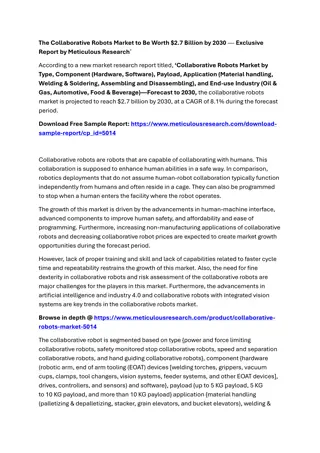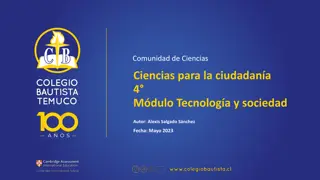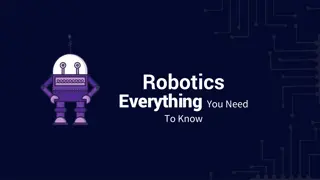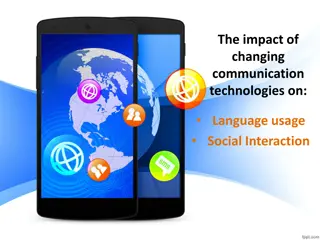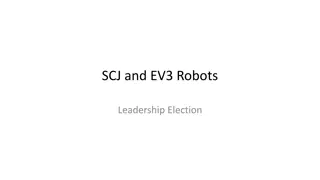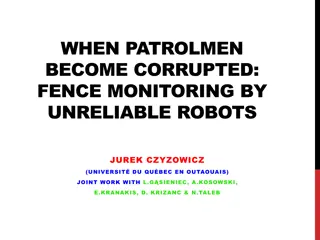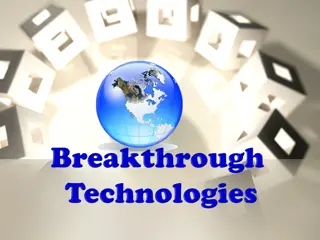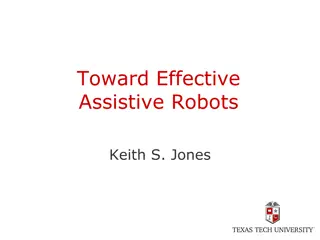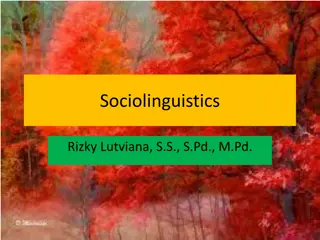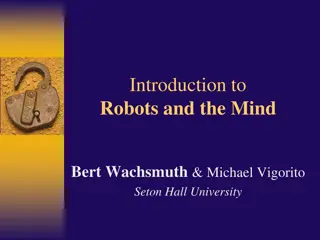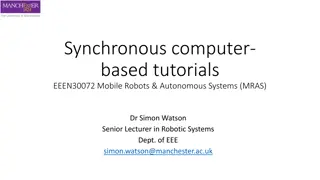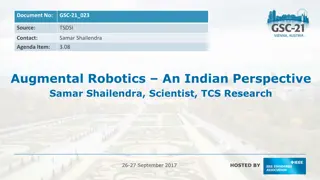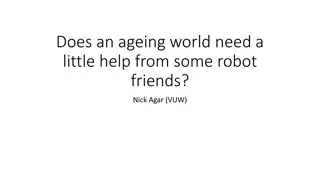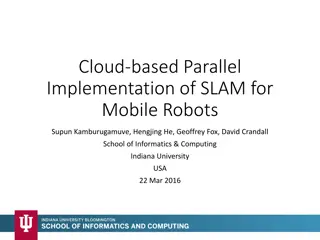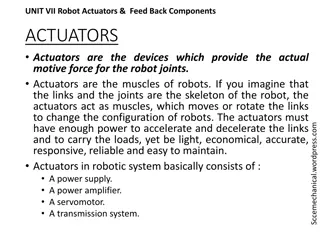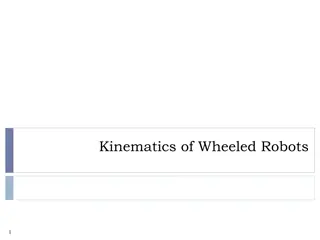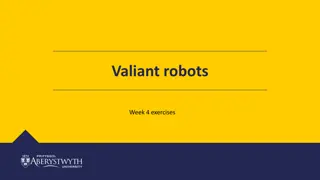Social Robots and Language Evolution
In the exploration of social robots and the evolution of languages, this content discusses the interaction between robots and humans, the development of languages in hunter-gatherer times, and innovative solutions like the build-it-yourself solar still for obtaining drinking water. The content also touches upon the potential use of enzymes to break down plastics in landfills.
Download Presentation

Please find below an Image/Link to download the presentation.
The content on the website is provided AS IS for your information and personal use only. It may not be sold, licensed, or shared on other websites without obtaining consent from the author.If you encounter any issues during the download, it is possible that the publisher has removed the file from their server.
You are allowed to download the files provided on this website for personal or commercial use, subject to the condition that they are used lawfully. All files are the property of their respective owners.
The content on the website is provided AS IS for your information and personal use only. It may not be sold, licensed, or shared on other websites without obtaining consent from the author.
E N D
Presentation Transcript
1. What can we infer about the social robots from the last paragraph? 2. What can we infer about the author from the first paragraph? 3. It can be inferred from the last paragraph that the chemical might . 4. What can we infer from the last paragraph? 21 What can be inferred from the passage? A. Animals and plants won t die out as long as climate changes slowly. B. There s enough data for us to predict the future of climate change. C. The world is getting more unstable because of animal migration. D. The earth is not the only planet that is experiencing climate change.
1. The more interaction the robot has with human, the more it learns. But Oshbot, like other social robots, is not intended to replace workers, but to work alongside other employees. We have technologies to train social robots to do things not for us, but with us, said Breazeal. 1. What can we infer about the social robots from the last paragraph? A.They will train employees. B. They will be our workmates. C. They will improve technologies. D. They will take the place of workers. Tips 1. 2. 3.
Practice Languages have been coming and going for thousands of years, but in recent times there has been less coming and a lot more going. When the world was still populated by hunter-gatherers, small, tightly knit ( ) groups developed their own patterns of speech independent of each other. Some language experts believe that 10,000 years ago, when the world had just five to ten million people, they spoke perhaps 12,000 languages between them. 2. What can we infer about languages in hunter-gatherer times? A. They developed very fast. B. They were large in number. C. They had similar patterns. D. They were closely connected.
Practice A build-it-yourself solar still ( ) is one of the best ways to obtain drinking water in areas where the liquid is not readily available. Developed by two doctors in the U.S. Department of Agriculture, it s an excellent water collector. Unfortunately, you must carry the necessary equipment with you, since it s all but impossible to find natural substitutes. The only components required, though, are a 5 5 sheet of clear or slightly milky plastic, six feet of plastic tube, and a container perhaps just a drinking cup to catch the water. These pieces can be folded into a neat little pack and fastened on your belt. 3. What do we know about the solar still equipment from the first paragraph? A. It s delicate. B. It s expensive. C. It s complex. D. It s portable.
Practice Bertocchini agrees and hopes her team s findings might one day help employ the enzyme ( ) to break down plastics in landfills. But she expects using the chemical in some kind of industrial process not simply millions of worms thrown on top of the plastic. 4. It can be inferred from the last paragraph that the chemical might . A. help to raise worms B. help make plastic bags C. be used to clean the oceans. D. be produced in factories in future
2. Does this mean that plants talk to each other? Scientists don t know. Maybe the first plant just made a cry of pain or was sending a message to its own branches, and so, in effect, was talking to itself. Perhaps the neighbors just happened to overhear the cry. So information was exchanged, but it wasn t a true, intentional back and forth. Charles Darwin, over 150 years ago, imagined a world far busier, noisier and more intimate ( ) than the world we can see and hear. Our senses are weak. There s a whole lot going on. 5. What can we infer from the last paragraph? A.The world is changing faster than ever. B. People have stronger senses than before. C. The world is more complex than it seems. D. People in Darwin s time were imaginative. Tips 1. 2. 3.
Practice By the end of his lifetime, Frost had become a famous and beloved American poet. His poems describe the everyday details of rural life and reveal his complexity, independent spirit, and often humorous view of the world. Frost s biographer ( ) wrote of him: He was a loner who liked company; a poet of isolation ( ) who sought a mass audience; an outsider who sought to fit in...While preferring to stay at home, he traveled more than any poet of his generation to give lectures and readings, even though he remained frightened of public speaking to the end. 6. It can be inferred from the last paragraph that A. poets of Frost s time didn t like giving lectures B. Frost s poetry is very complex but entertaining C. there is apparent contradiction in Frost s character D. Frost s biographer wasn t honest about his experience .
1. 1. Where is the text probably from? 2. In which section of a newspaper may this text appear?
1. a guidebook an advertisement an announcement an exhibition guide a travel brochure autobiography science fiction a novel a diary children s literature a science report a research plan a science magazine a health magazine a research paper science fiction a science report a book review an exhibition guide a biology textbook a travel brochure children s literature a research plan autobiography an announcement a health magazine a guidebook a business report a book review an official report a biology textbook an advertisement a science magazine a business report an official report a research paper a novel Tips 1. 2. 3. a diary
Practice A science magazine The more interaction the robot has with human, the more it learns. But Oshbot, like other social robots, is not intended to replace workers, but to work alongside other employees. We have technologies to train social robots to do things not for us, but with us, said Breazeal. A magazine Languages have been coming and going for thousands of years, but in recent times there has been less coming and a lot more going. When the world was still populated by hunter-gatherers, small, tightly knit ( ) groups developed their own patterns of speech independent of each other. Some language experts believe that 10,000 years ago, when the world had just five to ten million people, they spoke perhaps 12,000 languages between them. A science magazine A build-it-yourself solar still ( ) is one of the best ways to obtain drinking water in areas where the liquid is not readily available. Developed by two doctors in the U.S. Department of Agriculture, it s an excellent water collector. Unfortunately, you must carry the necessary equipment with you, since it s all but impossible to find natural substitutes. The only components required, though, are a 5 5 sheet of clear or slightly milky plastic, six feet of plastic tube, and a container perhaps just a drinking cup to catch the water. These pieces can be folded into a neat little pack and fastened on your belt.
Practice A science magazine Bertocchini agrees and hopes her team s findings might one day help employ the enzyme ( ) to break down plastics in landfills. But she expects using the chemical in some kind of industrial process not simply millions of worms thrown on top of the plastic. A science magazine/report Does this mean that plants talk to each other? Scientists don t know. Maybe the first plant just made a cry of pain or was sending a message to its own branches, and so, in effect, was talking to itself. Perhaps the neighbors just happened to overhear the cry. So information was exchanged, but it wasn t a true, intentional back and forth. Charles Darwin, over 150 years ago, imagined a world far busier, noisier and more intimate ( ) than the world we can see and hear. Our senses are weak. There s a whole lot going on. A biography By the end of his lifetime, Frost had become a famous and beloved American poet. His poems describe the everyday details of rural life and reveal his complexity, independent spirit, and often humorous view of the world. Frost s biographer ( ) wrote of him: He was a loner who liked company; a poet of isolation ( ) who sought a mass audience; an outsider who sought to fit in...While preferring to stay at home, he traveled more than any poet of his generation to give lectures and readings, even though he remained frightened of public speaking to the end.
As cultural symbols go, the American car is quite young. The Model T Ford was built at the Piquette Plant in Michigan a century ago, with the first rolling off the assembly line ( ) on September 27, 1908. Only eleven cars were produced the next month. But eventually Henry Ford would build fifteen million of them. Modern America was born on the road, behind a wheel. The car shaped some of the most lasting aspects of American culture: the roadside diner, the billboard, the motel, even the hamburger. For most of the last century, the car represented what it meant to be American going forward at high speed to find new worlds. The road novel, the road movie, these are the most typical American ideas, born of abundant petrol, cheap cars and a never-ending interstate highway system, the largest public works project in history. 8. Why is hamburger mentioned in paragraph 2? A. To explain Americans love for travelling by car. B. To show the influence of cars on American culture. C. To stress the popularity of fast food with Americans. D. To praise the effectiveness of America s road system. Tips 1. 2. 3.
Practice Money with no strings attached. It s not something you see every day. But at Union Station in Los Angeles last month, a board went up with dollar bills attached to it with pins and a sign that read, "Give What You Can, Take What You Need." People quickly caught on. And while many took dollars, many others pinned their own cash to the board. People of all ages, races, and socio-economic ( ) backgrounds gave and took, said Tyler Bridges of The Toolbox, which created the project. We even had a bride in her wedding dress come up to the board and take a few dollars. Most of the bills on the board were singles, but a few people left fives, tens and even twenties. The video clip ( ) shows one man who had found a $ 20 bill pinning it to the board. 9. What did Bridges want to show by mentioning the bride? A.Women tended to be more sociable. B.The activity attracted various people. C.Economic problems were getting worse. D.Young couples needed financial assistance.
Tips 1. 2. 3. Tips 1. 2. 3.



